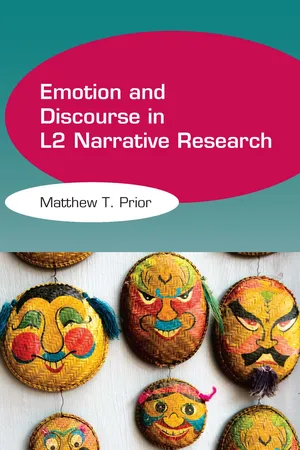1Getting Emotional
Emotions play a crucial part in our lives. The sharing of emotions,
whether in face-to-face interactions or through written communications
is an important social activity, and the ability to do so helps us maintain physical and mental health.
(Dewaele, 2013: 208)
Investigations of the role of affect in language cannot proceed without a fine-grained ethnographic inquiry into language use in context ... Ideal contexts for the study of the relationship between language and emotional life are situations in which emotions themselves become the focus of attention ... and the ethnographic interview itself ... can provide rich ethnographic opportunities for such investigations.
(Besnier, 1990: 437–438)
Due to its personal and in-depth focus, narrative or autobiographical1 research (terms used here as shorthand for qualitative, interview-based research involving first-person accounts, tellings, life stories and related talk of memorable episodes, turning points and other personal experiences) is often described as a highly confessional activity (e.g. Atkinson, 1998; Coffey, 2004; Gubrium et al., 2012; Riessman, 2008; Weiss, 1994). It seems only fitting to begin with a confession: this is not really a book about emotion. Neither is it centrally about ‘feelings’, ‘moods’, ‘subjectivities’ or whatever other descriptive labels popularly used to refer to affective phenomena.2 This may appear a contradictory way to introduce a chapter titled ‘Getting Emotional’ in a book promising ‘Emotion and Discourse’, but it is crucial for understanding the approach informing these chapters.
What, then, is this book about? The short answer is that it is concerned with the interactional construction and management of emotionality in L2 (second language) autobiographical interview research. The distinction made here between emotion and emotionality is more than semantic. Turning attention to emotionality reframes emotions as social actions rather than intra-psychological properties or ‘thing-like entities’ (Sarbin, 2001: 217) waiting to be discovered or measured. This action orientation engages with affective and other putatively ‘psychological’ components of speakers’ identities and experiences by exploring the dynamic, dilemmatic, (in)consistent, multilayered and agentive aspects of their representation. Thus this book contributes to the investigation of emotionality and autobiographical talk by turning the analytical lens on a surprisingly under-examined aspect of scholarly research: our own practices. By advancing a discursive constructionist approach, it offers a timely methodological and interaction-based perspective that examines how emotionality is collaboratively managed as both topic and resource within the institutional and interpersonal business of qualitative research.
Located in the context of contemporary narrative and ethnographic inquiry on multilingual identities and transcultural flows, this interdisciplinary project weaves together discussions and analyses based on the L1 (first language) and L2 literatures as well as original research I carried out with adult immigrants from Southeast Asia living in the United States and Canada. Although this book addresses issues of relevance for qualitative research practice in general, its primary audience is scholars in L2 studies (including the various intersecting fields, domains and disciplines of second and foreign language studies, applied linguistics, TESOL (Teaching English to speakers of other languages) and related bi/multilingualism research). Even within L2 studies, autobiographical interview research is not a unitary program but encompasses a wide range of methodologies, topics, theoretical and philosophical perspectives and approaches to data generation and analysis. Recognizing this diversity, I invite readers to compare the issues explored here with their own sociolinguistic contexts, speakers and data of interest.
I must emphasize that this is not a ‘how-to’ text or manual. It will not present a list of procedures specifying how to conduct autobiographical inquiry or analyze narratives; neither will it offer guidelines stipulating what constitutes a ‘good’ or a ‘bad’ narrative or research interview. These chapters open up various interview activities and products for inspection, and readers are invited to co-analyze and develop their own informed conclusions. Because this book attends to research challenges and even ‘failures’ (Prior, 2014; Roulston, 2014), it may prove largely instructional on what not to do. Emotion is omnipresent, but I will nevertheless refrain from laying out a taxonomy of emotion or proposing yet another theory of affect. Herein I advocate approaching emotionality and autobiographical tellings as discursive, social practices, and I aim to show there are compelling grounds for this. However, I do not assert this is the only approach or the final word on such matters. It is also not my intent to elevate stories of hardship over stories of success or ‘negative’ emotions over ‘positive’ ones. This investigation opens up just as many questions as it answers. Therefore it embraces and seeks to make visible the inherent tensions and ‘messiness’ of autobiographical research and qualitative inquiry more broadly.
In the remainder of the chapter I describe in more detail the background, motivations and objectives of this project. I begin with a brief overview of the recent growth of emotion research and the ways in which it intersects with autobiographical inquiry. I then address concerns about researcher reflexivity and implications for exploring the affective interface of research practice. Concluding the Introduction, I describe the L2 research context, the focal participants and the data that inform these chapters.
A Brief Emotional History
Getting emotional in L2 research
There is no doubt we are getting emotional. Across the interdisciplinary field of L2 studies, scholars are increasingly taking a keen interest in investigating the forms and functions of emotion in human language life. Where once there was only a scattered collection of monographs and articles that addressed emotion and affective variables (e.g. Arnold, 1999; Horwitz et al., 1986; Rintell, 1984, 1990; Schumann, 1997; Scovel, 1978), we now have a rapidly expanding library of emotion-relevant scholarship from diverse yet often intersecting perspectives such as L2 motivation (e.g. Dörnyei, 2009; Dörnyei & Kubanyiova, 2014; Dörnyei et al., 2014; Dörnyei & Ushioda, 2009, 2011; Murray et al., 2011; Oxford, 2011), bi/multilingualism and cognitive processing (e.g. Dewaele, 2005, 2006, 2010; Dewaele & Pavlenko, 2002; Koven, 2004; Pavlenko, 2005, 2006); critical pedagogy (e.g. Benesch, 2011; Crookes, 2013); sociocultural approaches (e.g. Garrett & Young, 2009; Swain et al., 2011; Zuengler & Miller, 2003); language socialization (e.g. Baquedano-López, 2004; Garrett & Baque...
